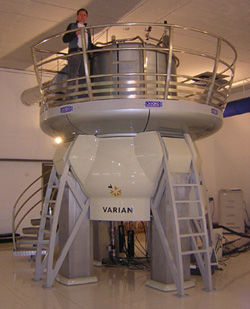Resonance

|
WikiDoc Resources for Resonance |
|
Articles |
|---|
|
Most recent articles on Resonance |
|
Media |
|
Evidence Based Medicine |
|
Clinical Trials |
|
Ongoing Trials on Resonance at Clinical Trials.gov Clinical Trials on Resonance at Google
|
|
Guidelines / Policies / Govt |
|
US National Guidelines Clearinghouse on Resonance
|
|
Books |
|
News |
|
Commentary |
|
Definitions |
|
Patient Resources / Community |
|
Patient resources on Resonance Discussion groups on Resonance Directions to Hospitals Treating Resonance Risk calculators and risk factors for Resonance
|
|
Healthcare Provider Resources |
|
Causes & Risk Factors for Resonance |
|
Continuing Medical Education (CME) |
|
International |
|
|
|
Business |
|
Experimental / Informatics |
Overview
In physics, resonance is the tendency of a system to oscillate at larger amplitude at some frequencies than at others. These are known as the system's resonance frequencies (or resonant frequencies). At these frequencies, even small periodic driving forces can produce large amplitude vibrations, because the system stores vibrational energy. When damping is small, the resonance frequency is approximately equal to the natural frequency of the system, which is the frequency of free vibrations. Resonant phenomena occur with all types of vibrations or waves: there is mechanical resonance, acoustic resonance, electromagnetic resonance, Nuclear Magnetic Resonance (NMR), Electron Spin Resonance (ESR) and resonance of quantum wave functions. Resonant systems can be used to generate vibrations of a specific frequency, or pick out specific frequencies from a complex vibration containing many frequencies.
Resonance was discovered by Galileo Galilei with his investigations of pendulums beginning in 1602.
Orbital resonance
In celestial mechanics, an orbital resonance occurs when two orbiting bodies exert a regular, periodic gravitational influence on each other, usually due to their orbital periods being related by a ratio of two small integers. Orbital resonances greatly enhance the mutual gravitational influence of the bodies. In most cases, this results in an unstable interaction, in which the bodies exchange momentum and shift orbits until the resonance no longer exists. Under some circumstances, a resonant system can be stable and self correcting, so that the bodies remain in resonance. Examples are the 1:2:4 resonance of Jupiter's moons Ganymede, Europa, and Io, and the 2:3 resonance between Pluto and Neptune. Unstable resonances with Saturn's inner moons give rise to gaps in the rings of Saturn. The special case of 1:1 resonance (between bodies with similar orbital radii) causes large Solar System bodies to clear the neighborhood around their orbits by ejecting nearly everything else around them; this effect is used in the current definition of a planet.
Atomic, particle, and molecular resonance
Nuclear magnetic resonance (NMR) is the name given to a physical resonance phenomenon involving the observation of specific quantum mechanical magnetic properties of an atomic nucleus in the presence of an applied, external magnetic field. Many scientific techniques exploit NMR phenomena to study molecular physics, crystals and non-crystalline materials through NMR spectroscopy. NMR is also routinely used in advanced medical imaging techniques, such as in magnetic resonance imaging (MRI).
All nuclei that contain odd numbers of nucleons have an intrinsic magnetic moment and angular momentum. A key feature of NMR is that the resonance frequency of a particular substance is directly proportional to the strength of the applied magnetic field. It is this feature that is exploited in imaging techniques; if a sample is placed in a non-uniform magnetic field then the resonance frequencies of the sample's nuclei depend on where in the field they are located. Therefore, the particle can be located quite precisely from its resonance frequency.
Electron paramagnetic resonance, otherwise known as Electron Spin Resonance (ESR) is a spectroscopic technique similar to NMR used with unpaired electrons instead. Materials for which this can be applied are much more limited since the material needs to both have an unpaired spin and be paramagnetic.
The Mössbauer effect is a physical phenomenon discovered by Rudolf Mößbauer in 1957; it refers to the resonant and recoil-free emission and absorption of gamma ray photons by atoms bound in a solid form.
Resonance (particle): In quantum mechanics and quantum field theory resonances may appear in similar circumstances to classical physics. However, they can also be thought of as unstable particles, with the formula above still valid if the <math>\Gamma</math> is the decay rate and <math>\Omega</math> replaced by the particle's mass M. In that case, the formula just comes from the particle's propagator, with its mass replaced by the complex number <math>M+i\Gamma</math>. The formula is further related to the particle's decay rate by the optical theorem.
See also
External links
- Definition of Resonance - "The increase in amplitude of oscillation of an electric or mechanical system exposed to a periodic force whose frequency is equal or very close to the natural undamped frequency of the system."
- Resonance - a chapter from an online textbook
- Greene, Brian, "Resonance in strings". The Elegant Universe, NOVA (PBS)
- Hyperphysics section on resonance concepts
- A short FAQ on quantum resonances
- Resonance versus resonant (usage of terms)
- Wood and Air Resonance in a Harpsichord
- Java applet demonstrating resonances on a string when the frequency of the driving force is varied
- Breaking glass with sound, including high-speed footage of glass breaking
ar:رنين (فيزياء) bs:Rezonanca bg:Резонанс cs:Rezonance da:Resonans (fysik) de:Resonanz (Physik) et:Resonants fa:تشدید (فیزیک) ko:공명 hi:अनुनाद hr:Rezonancija it:Risonanza (fisica) he:תהודה lt:Rezonansas hu:Rezonancia ms:Resonan nl:Resonantie no:Resonans sl:Resonanca fi:Resonanssi sv:Resonans th:การสั่นพ้อง uk:Резонанс